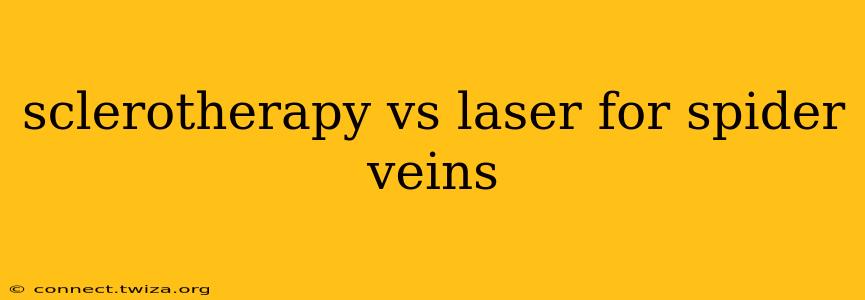Spider veins, those tiny, bluish-purple, web-like veins that often appear on the legs, can be a cosmetic concern for many. Fortunately, there are several effective treatment options available, with sclerotherapy and laser treatment being two of the most popular. Choosing the right method depends on various factors, including the severity of your spider veins, your skin type, and your personal preferences. This comprehensive guide will delve into the details of each treatment, helping you make an informed decision.
What is Sclerotherapy?
Sclerotherapy is a minimally invasive procedure that involves injecting a sclerosant solution directly into the spider veins. This solution irritates the vein lining, causing it to collapse and eventually fade from view. The treated veins are then absorbed by the body over time. The procedure is typically performed in a doctor's office and requires little to no downtime.
Advantages of Sclerotherapy:
- High Success Rate: Sclerotherapy boasts a high success rate for treating spider veins, particularly smaller ones.
- Minimal Downtime: You can usually return to your normal activities immediately after the procedure.
- Relatively Low Cost: Compared to laser treatment, sclerotherapy is often more affordable.
- Suitable for Various Vein Sizes: While particularly effective for smaller veins, sclerotherapy can sometimes be used for larger ones.
Disadvantages of Sclerotherapy:
- Multiple Sessions May Be Needed: Depending on the severity of your spider veins, you might require multiple treatment sessions.
- Potential Side Effects: While rare, side effects can include bruising, swelling, pain, and discoloration at the injection site.
- Not Suitable for All Vein Types: Sclerotherapy may not be as effective for larger veins or those close to the skin's surface.
What is Laser Treatment for Spider Veins?
Laser treatment uses intense pulsed light (IPL) or laser energy to target and destroy the affected veins. The heat from the laser closes off the veins, preventing blood flow and causing them to fade over time. Like sclerotherapy, this procedure is typically performed in a doctor's office.
Advantages of Laser Treatment:
- Treats Larger Areas Quickly: Laser treatment can efficiently treat larger areas of spider veins in a shorter amount of time compared to sclerotherapy.
- Minimal Discomfort: Most patients report minimal discomfort during the procedure.
- Improved Skin Tone: In some cases, laser treatment can also improve skin tone and texture.
Disadvantages of Laser Treatment:
- Higher Cost: Laser treatment is generally more expensive than sclerotherapy.
- Potential Side Effects: Possible side effects include redness, swelling, blistering, and changes in skin pigmentation.
- May Require Multiple Sessions: Similar to sclerotherapy, multiple treatments might be necessary for optimal results.
- Not Suitable for All Skin Types: Laser treatment may not be as effective or safe for all skin types, particularly darker skin tones.
Which Treatment is Better for Me? Sclerotherapy or Laser?
The "best" treatment depends entirely on individual circumstances. Factors to consider include:
- Severity and Location of Spider Veins: Sclerotherapy is often preferred for smaller, individual spider veins, while laser treatment is better suited for larger areas or more extensive veining.
- Skin Type and Tone: Laser treatment may not be ideal for individuals with darker skin tones due to the risk of hyperpigmentation.
- Budget: Sclerotherapy is usually less expensive than laser treatment.
- Personal Preferences and Tolerance for Discomfort: Consider your comfort level with injections (sclerotherapy) versus heat (laser treatment).
How Much Does Each Treatment Cost?
The cost of both sclerotherapy and laser treatment can vary widely depending on several factors, including the number of treatment sessions required, the size of the treated area, and the geographic location. It's best to consult with a qualified healthcare professional for a personalized cost estimate.
What is the Recovery Time for Each Treatment?
Both sclerotherapy and laser treatment generally have minimal downtime. You can usually return to your normal activities immediately after the procedure, although some mild discomfort or bruising may occur. Your doctor will provide specific post-treatment care instructions.
Are there any risks or complications associated with these treatments?
While generally safe, both sclerotherapy and laser treatment carry potential risks and complications. These can include bruising, swelling, pain, discoloration, and infection. It's crucial to discuss these risks with your doctor before undergoing either procedure.
Can I use both sclerotherapy and laser treatment together?
In some cases, a combination of sclerotherapy and laser treatment may be recommended to achieve the best possible results. Your doctor will determine if this approach is suitable for your specific needs.
This information is for educational purposes only and should not be considered medical advice. Always consult with a qualified healthcare professional to determine the best treatment option for your individual circumstances.
